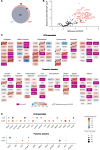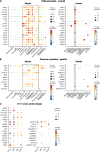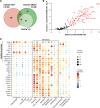A secretome atlas of cardiac fibroblasts from healthy and infarcted mouse hearts
- PMID: 40301568
- PMCID: PMC12041564
- DOI: 10.1038/s42003-025-08083-y
A secretome atlas of cardiac fibroblasts from healthy and infarcted mouse hearts
Abstract
Cardiac fibroblasts (CF) are key players after myocardial infarction (MI), but their signaling is only incompletely understood. Here we report a first secretome atlas of CF in control (cCF) and post-MI mouse hearts (miCF), combining a rapid cell isolation technique with SILAC and click chemistry. In CF, numerous paracrine factors involved in immune homeostasis are identified. Comparing secretome, transcriptome (SLAMseq), and cellular proteome disclose protein turnover. In miCF at day 5 post-MI, significantly upregulated proteins include SLIT2, FN1, and CRLF1 in mouse and human samples. Comparing the miCF secretome at days 3 and 5 post-MI reveals the dynamic nature of protein secretion. Specific in-vivo labeling of miCF proteins via biotin ligase TurboID using the POSTN promotor mirrors the in-vitro data. In summary, we identify numerous paracrine factors specifically secreted from CF in mice and humans. This secretome atlas may lead to new biomarkers and/or therapeutic targets for the activated CF.
© 2025. The Author(s).
Conflict of interest statement
Competing interests: The authors declare no competing interests.
Figures







References
-
- Frangogiannis, N. G. Cardiac fibrosis. Cardiovasc. Res. 10.1093/cvr/cvaa324 (2020).
-
- Aoki, T. et al. Prognostic impact of myocardial interstitial fibrosis in non-ischemic heart failure. -comparison between preserved and reduced ejection fraction heart failure. Circ. J. Jpn. Circ. Soc.75, 2605–2613 (2011). - PubMed
MeSH terms
Substances
Grants and funding
- 458365199/Deutsche Forschungsgemeinschaft (German Research Foundation)
- 407493903/Deutsche Forschungsgemeinschaft (German Research Foundation)
- 423957469/Deutsche Forschungsgemeinschaft (German Research Foundation)
- 458365199/Deutsche Forschungsgemeinschaft (German Research Foundation)
- 407493903/Deutsche Forschungsgemeinschaft (German Research Foundation)
LinkOut - more resources
Full Text Sources
Medical
Miscellaneous

